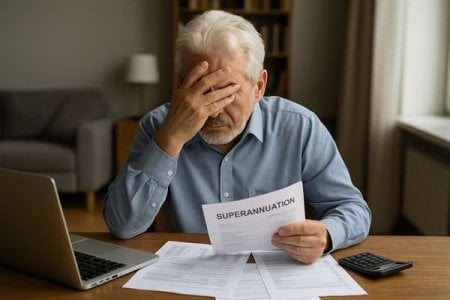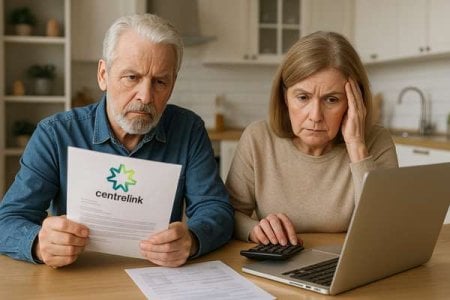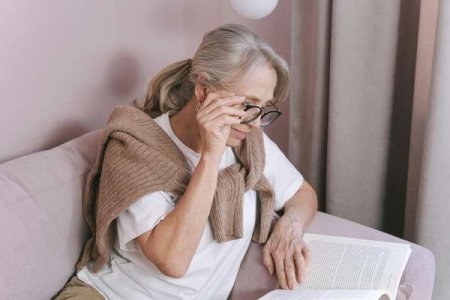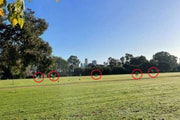Retirement ‘Nightmare’: Why Millions of Australians Could Be Stuck Relying on the Age Pension
By
Danielle G.
- Replies 1
More than 4 million Australians are now worried they won’t have enough superannuation to retire comfortably. It’s a stark wake-up call that’s been described as a looming “superannuation nightmare” in the headlines. After decades of work, many people are finding their super nest eggs coming up short – and the Centrelink Age Pension is looking like their only lifeline. But relying solely on the Age Pension to fund one’s golden years can be a risky bet. One finance expert, Pascale Helyar-Moray, cautions that falling back entirely on the pension in your twilight years could leave you facing “financial strain” and a very rough retirement. In other words, the Age Pension safety net might catch you – but it might not cushion your landing.
So how did we get here, and what does it really mean to spend your retirement living off the Age Pension? Let’s unpack the reality behind the “nightmare” and consider what seniors (and those about to retire) can do to navigate this challenge.
It turns out the average Australian’s super balance is far below what’s recommended for a comfortable retirement. New research highlights that while the Association of Superannuation Funds of Australia (ASFA) recommends a single person have about $595,000 saved for a comfortable life after work (and around $690,000 for a couple), the typical Aussie has nowhere near that. In fact, Australian Taxation Office data shows the average super balance is roughly $172,000 – but the median (the middle value) tells an even more sobering story: just $66,000 for men and $52,000 for women. Those figures are miles below the half-million dollars-plus that might be needed. No wonder one in five people now say they’ll have to cut back on spending and 20% fear they may never be able to fully retire at all.
These numbers paint a “retirement dream” that could be slipping out of reach for millions of Aussies. “Insufficient super or savings could see millions of Aussies facing financial strain in their later years,” warns Helyar-Moray, who worked on the Finder survey behind these findings. “More and more people are worried that retirement will arrive before the money does, leaving them underprepared”, she said. It’s a striking image: retirement knocking on the door, but the piggy bank is close to empty.
So where do people expect to turn if their super runs dry? Increasingly, the fallback plan is Centrelink’s Age Pension. In the Finder study, a large share of respondents admitted they’ll have to rely on the Age Pension to make ends meet. This isn’t a small group, either – it could be millions of retirees leaning on government payments to get by. As Helyar-Moray bluntly puts it, “The Age Pension isn’t guaranteed – your assets could disqualify you from receiving it”. In other words, some people might plan on the pension helping them out, only to find out they have just enough assets (perhaps in property or savings) to miss out on full benefits. It’s a precarious position: too little money to live comfortably, but too much to qualify for substantial pension support.
The Age Pension in Australia is designed as a safety net for those who don’t have sufficient income or assets in retirement. It’s been a cornerstone of our retirement system for decades – but it was never meant to be a golden ticket to luxury. If anything, it’s meant to provide a basic, no-frills income to cover essential living costs. As of March 2025, the full Age Pension for a single person is about $1,149 per fortnight (roughly $29,900 a year), and about $1,732 a fortnight for a couple combined (around $45,000 a year). That’s what you get if you qualify for the full pension. By comparison, ASFA’s “comfortable” retirement standard implies an annual income of around $46,000-$49,000 for a single – meaning even at the maximum rate, the Age Pension alone doesn’t quite reach a “comfortable” lifestyle benchmark. It’s closer to what’s considered a “modest” retirement living standard, covering basics but little in the way of extra treats or buffers.
Importantly, not everyone qualifies for the full pension. Australia’s system is means-tested, which is a fancy way of saying the government looks at what you already have – income, savings, investments, property – and decides how much pension you need. There are two tests: an income test and an assets test. If you have income (like earnings, investment returns, rental income) above a certain small threshold, your pension entitlement starts reducing (at a rate of 50 cents less pension per dollar of extra income). Similarly, if your assets (things like shares, bank balances, investment properties – notably not including your primary home) exceed specific limits, your pension gets reduced $3 per fortnight for every $1,000 above the threshold. Own a lot of assets? You might get only a part pension or none at all if you’re above the cutoff. For example, a single homeowner with more than about $697,000 in assets (beyond their home) wouldn’t get any Age Pension under current rules.
The logic behind this is to target the Age Pension to those who need it most. It’s taxpayer-funded, so most people agree it should go to seniors who genuinely lack other resources. But it also means some self-funded retirees who did manage to save a decent (but not lavish) amount might fall into a gap: they have too much for a pension, yet not enough to feel secure for 20-30 years of retirement. Meanwhile, those who do qualify have, by definition, low assets and low income – and must make the most of that ~$30k a year (for singles) or $45k (for couples) to cover all their needs.
How many older Australians end up relying on the Age Pension? The answer: a lot. In fact, roughly 70% of Australians over 65 receive some level of Age Pension (full or part). Government data in 2022-23 showed 43% of retirees count a government pension as their main source of income in retirement – that’s almost half of all retired people depending primarily on Centrelink to pay the bills. Only about 27% of retirees were living mainly off their superannuation or other private savings/investments. It’s a striking reality – despite the rise of compulsory superannuation since the 1990s, most older Aussies still lean on the pension to some extent. Part of that is a generational issue: today’s retirees didn’t enjoy a full working life of 10-12% employer super contributions. Many relied on manual jobs or raised families in eras where super wasn’t mandatory (compulsory employer super only began in 1992). As a result, their super balances tend to be lower, and the pension fills the gap.
For women, the reliance is even higher. Why? Because women, on average, retire with significantly less super than men. Some eye-opening stats: about one in three Australian women retires with no super at all, and those who do have savings often end up with less than half the superannuation of their male counterparts. As Nicola McDougall, a financial author and advocate, has noted, “about 70 per cent of women also rely on the pension to financially survive in retirement”. That 70% figure for women underscores how critical the Age Pension is, especially for women who took time out of the workforce for children or worked in lower-paid or part-time roles. The super system simply “was not designed to accommodate” careers with significant breaks or the gender pay gap, McDougall explains. The result is that many older women have little in their super and must fall back on the Age Pension – often as their sole income.
Most Australians can’t even access the Age Pension until age 67 (the pension age was gradually increased from 65 to 67 as of 2023). For some older workers, that’s a problem right now. Consider the story of Ross, a 66-year-old former manual labourer. Ross began working as a builder at 15 and spent decades on construction sites. By his early 60s, after a lifetime of heavy physical work, his body was “destroyed”. He had to stop working at age 63 due to health issues and burnt through what little savings and super he had, long before reaching pension age. For the past four years, Ross has been “surviving on Centrelink payments” – in his case, JobSeeker unemployment benefits – and counting down the days until he turned 67. “It’s been a real battle,” he told the ABC, “and you shouldn’t wish your life away, but I wish a long time ago that I was pension age”. In other words, he simply couldn’t keep working, yet wasn’t old enough to get the pension – a frightening limbo that forced him to live on welfare payments significantly lower than the Age Pension. Ross’s situation sparked calls for more flexibility – like letting people in physically demanding jobs access the pension a bit earlier – but for now, the rules are the rules. His case is a powerful reminder: plenty of Aussies hit retirement age with broken bodies and meagre super, and rely on government support just to stay afloat.
For those who end up on the Age Pension with little or no other savings, what is life like? In a word, it can be tight. The Age Pension does get adjusted twice a year for inflation and wages, and Australia’s system is actually more sustainable than many countries’ (our pension is means-tested and relatively modest in amount, whereas some nations have generous universal pensions straining public coffers). But from the household perspective, trying to live on the pension can mean serious belt-tightening.
Multiple reports have found that a significant number of Age Pensioners live in poverty. One study described the Age Pension as “wholly inadequate,” noting that about 500,000 older Australians – roughly one-third of all those on the pension – are living well below the poverty line. If you’re a single pensioner who owns your home outright, the base pension (no rent assistance) still leaves you with an income below the poverty line by about $56 per week. For those who don’t own a home and have to pay rent, it’s even more dire – housing costs devour a huge chunk of their pension. In fact, home ownership is the most important determinant of a pensioner’s financial comfort: those who rent have vastly worse outcomes.
An elderly pensioner pushes a shopping cart with groceries. Many Australians relying solely on the Age Pension must budget carefully, often cutting back on essentials to make ends meet.
Research by the Grattan Institute in 2025 put it bluntly: among retirees who rent privately, two in every three are living in poverty. Picture that: if you’re retired, don’t own a home, and you’re renting on just the pension (even with a bit of rent assistance), the odds are basically 2 out of 3 that you’re below the poverty line. Grattan’s Brendan Coates notes that while most Australian retirees (particularly homeowners) are “doing pretty well” financially, “it’s retirees who rent who are really struggling… they’re in a lot of strife.”. This problem is expected to get worse in the future as home ownership rates decline. “Home ownership is falling, and it’s falling fast,” Coates explains, “Today’s older renters who are in work are tomorrow’s renting retirees. We’re going to see more people renting in future, and many renters are not on track to have enough savings through their super to cover the cost of rent.” In other words, unless something changes, we’re facing a future where more older Australians will enter retirement still paying rent, and many will have no choice but to rely on the Age Pension – which simply doesn’t stretch far enough in the rental market.
To put some figures around that: even after recent boosts to Commonwealth Rent Assistance (the government payment to help pensioners and others with rent), a single retiree on full Age Pension and rent assistance can afford only about 4% of one-bedroom rentals in Sydney, and around 13-14% of those in Brisbane and Melbourne. That’s a shockingly small sliver of the housing market. It means many are forced to live in suboptimal or far-flung housing, or spend an unsustainable portion of their income on rent. The basic math of a pension budget is grim once you factor in high housing costs: there’s little left over for other essentials, let alone any comforts.
Even those who own a home aren’t exactly living large on the pension. By the time the bills (rates, utilities, groceries, medical costs) are paid, a full single pension (≈$575 per week) doesn’t allow for a lavish lifestyle. Many pensioners have to make tough choices. In a report on pensioner living standards, researchers found stories of elderly Australians skipping meals to afford medication, blending solid food into soups because they can’t afford dental work, and even keeping the hot water off in summer to save on power bills. It’s heartbreaking and real. “The very ordinary demands of contemporary Australian life place so much stress on their finances that many [pensioners] are teetering on the edge of poverty and deprivation,” said the CEO of the Benevolent Society, one of the report’s authors.
None of this is to say the Age Pension has no value – without it, millions more would be destitute. Australia has comparatively lower rates of outright elderly destitution than some countries, precisely because the Age Pension (combined with things like the Medicare system and concession discounts) provides a baseline of support. But that baseline often amounts to a just-getting-by existence. Retirees who envisioned holidays, hobbies, or spoiling the grandkids may find those dreams curtailed if the pension is their only income. As Helyar-Moray warns, falling back exclusively on the pension could mean accepting a far lower standard of living than one might hope for. The Age Pension can keep the wolf from the door, but it might not keep all comfort and worry at bay.
We’ve touched on a couple of groups already: women and renters are high on the list of those at risk of a pension-dependent retirement. Let’s delve a bit deeper into why.
If you’re reading this and starting to feel a bit anxious – especially if you’re in your 50s or 60s and your super isn’t where you’d like it to be – take a deep breath. There are some steps and strategies that can help shore up your retirement situation. They may not all be easy, but they’re worth considering:
It’s also important to ensure you’re claiming everything you’re entitled to. Aside from the Age Pension itself, there are supplements (like the Pension Supplement and Energy Supplement, which are usually included in that fortnightly amountabc.net.au), and if you’re renting, definitely apply for Rent Assistance. There are also myriad discounts – state governments offer seniors discounts on public transport, council rates, and more; utility providers have hardship programs and pensioner discounts; even many private businesses give seniors a break. It might feel humbling to chase discounts, but remember you’ve earned this support through a lifetime of contributions to society.
On a broader scale, what’s being done (or should be done) to address this looming retirement income challenge? The situation of millions potentially relying on the Age Pension has not gone unnoticed by experts and policymakers, and there are ongoing debates on how to improve Australians’ retirement outcomes.
One positive development is that the Superannuation Guarantee (SG) – the compulsory employer contribution – is finally reaching its intended target of 12% of wages (set to hit 12% by July 2025). This will benefit younger workers especially, so that down the track they’ll retire with more savings. However, that doesn’t directly help those retiring in the next few years, many of whom had decades of much lower SG rates (it was 9% for a long time). To address gaps like the one women face, the federal government decided to start paying superannuation on Paid Parental Leave (from July 2025). This is a significant policy aimed at reducing the “motherhood penalty” in super balances. It means that when a parent (usually the mother) takes government-paid parental leave, they will now get an SG contribution (at 12% of the payment) into their super account. Over time, this should help women accumulate more super and lessen reliance on the pension. It’s a long-term fix, though – it won’t aid women who are currently in their 60s and missed out on super during childrearing years in the 1980s or 90s.
There are also proposals around increasing the Age Pension or adjusting the means tests. Advocacy groups like the Benevolent Society and National Seniors have called for an independent tribunal to assess pension adequacy regularly (to take the politics out of pension raises). In 2009, the Age Pension rates got a significant one-off increase which actually did reduce poverty rates among seniors (especially single pensioners). Some economists argue another boost is due, given rising living costs. The poverty rates among Age Pensioners remain a concern – by some measures, Australia has a relatively high rate of elder poverty compared to other developed countries, largely concentrated among those who rent. Increasing Commonwealth Rent Assistance has near-universal support among policy wonks as a targeted way to help the most vulnerable (the government did raise it by the largest percentage in decades in 2023-24, but in dollar terms it’s still modest). For example, Coates from Grattan Institute urges further increases to rent assistance to reflect the reality of more retirees renting.
Other ideas floated include tweaking the assets test taper (which was tightened in 2017, resulting in some people losing part-pensions – some experts say that discouraged middle-income folks from saving more, since a bit of extra savings could cut your pension considerably). Another suggestion is to exempt more of the superannuation income from the pension income test to encourage voluntary annuities or income streams that provide a steady retirement income. The government’s Retirement Income Review concluded that overall, our system is effective and sustainable, but it acknowledged that certain groups – especially renters – have poor outcomes and that the Age Pension will continue to play a major role in supporting retirees for many years.
There’s also the question of financial literacy and planning: ensuring that people know early enough if they’re on track or not. Many of those 4 million worried Aussies perhaps could have benefited from better information or incentives to save more before it became a crisis. Schools and employers are gradually doing more to educate people on super and investing, but it may be too late for the baby boomer generation who are retiring now. For them, it’s about making the best of the hand they’ve been dealt – using the Age Pension and other resources as smartly as possible, and not being afraid to seek help if they’re struggling.
Australia’s retirement income system is often praised internationally for its balance of compulsory savings (superannuation) and a means-tested public pension to catch those who fall short. But on the ground, for millions of older Australians, that balance can feel awfully lopsided – with the weight hanging on the Age Pension side. Relying on the Age Pension as the main support in retirement often means a leaner lifestyle. It can be done, and many make it work with dignity and resourcefulness. Yet the fact that so many are headed in that direction – whether by circumstance or choice – raises big questions.
For individuals, the clear message is to plan early and often: boost your super when you can, be mindful of how decisions (like taking time out of work or working part-time) might affect your retirement, and take advantage of any opportunity to strengthen your financial position before you reach the Age Pension queue. For society and government, the challenge is ensuring that our elders don’t just survive in retirement, but can live with a measure of comfort and security. That might mean policy tweaks to pensions and rent assistance, continued support for superannuation improvements, and perhaps targeted help for those groups at greatest risk of hardship.
Ultimately, retirement is a phase of life that we’d like to look forward to – a well-earned rest, time with family, pursuit of hobbies, maybe a bit of travel. The prospect of it becoming a “nightmare” for a large chunk of the population is troubling, to say the least. We’ve heard the warnings from experts and seen the worrying statistics. Now it’s up to each of us, and our leaders, to respond. Do we simply hope for the best and fall back on the Age Pension, or do we double down on efforts to save and support ourselves (and each other) in old age? It’s a conversation well worth having, because after all, how do you envision your retirement – and what steps are you taking to make that vision a reality?
Read more:
Retiring But Not Relaxing: Australia’s Age Pension Maze
Higher asset thresholds deliver bigger Age Pension cheques from 1 July
Retired but still working? Here’s what you need to know about how it affects your Age Pension
So how did we get here, and what does it really mean to spend your retirement living off the Age Pension? Let’s unpack the reality behind the “nightmare” and consider what seniors (and those about to retire) can do to navigate this challenge.
The Superannuation Shortfall: A Looming Crisis
It turns out the average Australian’s super balance is far below what’s recommended for a comfortable retirement. New research highlights that while the Association of Superannuation Funds of Australia (ASFA) recommends a single person have about $595,000 saved for a comfortable life after work (and around $690,000 for a couple), the typical Aussie has nowhere near that. In fact, Australian Taxation Office data shows the average super balance is roughly $172,000 – but the median (the middle value) tells an even more sobering story: just $66,000 for men and $52,000 for women. Those figures are miles below the half-million dollars-plus that might be needed. No wonder one in five people now say they’ll have to cut back on spending and 20% fear they may never be able to fully retire at all.
These numbers paint a “retirement dream” that could be slipping out of reach for millions of Aussies. “Insufficient super or savings could see millions of Aussies facing financial strain in their later years,” warns Helyar-Moray, who worked on the Finder survey behind these findings. “More and more people are worried that retirement will arrive before the money does, leaving them underprepared”, she said. It’s a striking image: retirement knocking on the door, but the piggy bank is close to empty.
So where do people expect to turn if their super runs dry? Increasingly, the fallback plan is Centrelink’s Age Pension. In the Finder study, a large share of respondents admitted they’ll have to rely on the Age Pension to make ends meet. This isn’t a small group, either – it could be millions of retirees leaning on government payments to get by. As Helyar-Moray bluntly puts it, “The Age Pension isn’t guaranteed – your assets could disqualify you from receiving it”. In other words, some people might plan on the pension helping them out, only to find out they have just enough assets (perhaps in property or savings) to miss out on full benefits. It’s a precarious position: too little money to live comfortably, but too much to qualify for substantial pension support.
Counting on the Age Pension: Safety Net or Thin Ice?
The Age Pension in Australia is designed as a safety net for those who don’t have sufficient income or assets in retirement. It’s been a cornerstone of our retirement system for decades – but it was never meant to be a golden ticket to luxury. If anything, it’s meant to provide a basic, no-frills income to cover essential living costs. As of March 2025, the full Age Pension for a single person is about $1,149 per fortnight (roughly $29,900 a year), and about $1,732 a fortnight for a couple combined (around $45,000 a year). That’s what you get if you qualify for the full pension. By comparison, ASFA’s “comfortable” retirement standard implies an annual income of around $46,000-$49,000 for a single – meaning even at the maximum rate, the Age Pension alone doesn’t quite reach a “comfortable” lifestyle benchmark. It’s closer to what’s considered a “modest” retirement living standard, covering basics but little in the way of extra treats or buffers.
Importantly, not everyone qualifies for the full pension. Australia’s system is means-tested, which is a fancy way of saying the government looks at what you already have – income, savings, investments, property – and decides how much pension you need. There are two tests: an income test and an assets test. If you have income (like earnings, investment returns, rental income) above a certain small threshold, your pension entitlement starts reducing (at a rate of 50 cents less pension per dollar of extra income). Similarly, if your assets (things like shares, bank balances, investment properties – notably not including your primary home) exceed specific limits, your pension gets reduced $3 per fortnight for every $1,000 above the threshold. Own a lot of assets? You might get only a part pension or none at all if you’re above the cutoff. For example, a single homeowner with more than about $697,000 in assets (beyond their home) wouldn’t get any Age Pension under current rules.
The logic behind this is to target the Age Pension to those who need it most. It’s taxpayer-funded, so most people agree it should go to seniors who genuinely lack other resources. But it also means some self-funded retirees who did manage to save a decent (but not lavish) amount might fall into a gap: they have too much for a pension, yet not enough to feel secure for 20-30 years of retirement. Meanwhile, those who do qualify have, by definition, low assets and low income – and must make the most of that ~$30k a year (for singles) or $45k (for couples) to cover all their needs.
How many older Australians end up relying on the Age Pension? The answer: a lot. In fact, roughly 70% of Australians over 65 receive some level of Age Pension (full or part). Government data in 2022-23 showed 43% of retirees count a government pension as their main source of income in retirement – that’s almost half of all retired people depending primarily on Centrelink to pay the bills. Only about 27% of retirees were living mainly off their superannuation or other private savings/investments. It’s a striking reality – despite the rise of compulsory superannuation since the 1990s, most older Aussies still lean on the pension to some extent. Part of that is a generational issue: today’s retirees didn’t enjoy a full working life of 10-12% employer super contributions. Many relied on manual jobs or raised families in eras where super wasn’t mandatory (compulsory employer super only began in 1992). As a result, their super balances tend to be lower, and the pension fills the gap.
For women, the reliance is even higher. Why? Because women, on average, retire with significantly less super than men. Some eye-opening stats: about one in three Australian women retires with no super at all, and those who do have savings often end up with less than half the superannuation of their male counterparts. As Nicola McDougall, a financial author and advocate, has noted, “about 70 per cent of women also rely on the pension to financially survive in retirement”. That 70% figure for women underscores how critical the Age Pension is, especially for women who took time out of the workforce for children or worked in lower-paid or part-time roles. The super system simply “was not designed to accommodate” careers with significant breaks or the gender pay gap, McDougall explains. The result is that many older women have little in their super and must fall back on the Age Pension – often as their sole income.
Case in Point: When Work Becomes Impossible Before 67
Most Australians can’t even access the Age Pension until age 67 (the pension age was gradually increased from 65 to 67 as of 2023). For some older workers, that’s a problem right now. Consider the story of Ross, a 66-year-old former manual labourer. Ross began working as a builder at 15 and spent decades on construction sites. By his early 60s, after a lifetime of heavy physical work, his body was “destroyed”. He had to stop working at age 63 due to health issues and burnt through what little savings and super he had, long before reaching pension age. For the past four years, Ross has been “surviving on Centrelink payments” – in his case, JobSeeker unemployment benefits – and counting down the days until he turned 67. “It’s been a real battle,” he told the ABC, “and you shouldn’t wish your life away, but I wish a long time ago that I was pension age”. In other words, he simply couldn’t keep working, yet wasn’t old enough to get the pension – a frightening limbo that forced him to live on welfare payments significantly lower than the Age Pension. Ross’s situation sparked calls for more flexibility – like letting people in physically demanding jobs access the pension a bit earlier – but for now, the rules are the rules. His case is a powerful reminder: plenty of Aussies hit retirement age with broken bodies and meagre super, and rely on government support just to stay afloat.
Life on the Age Pension: Bare Essentials and Tough Choices
For those who end up on the Age Pension with little or no other savings, what is life like? In a word, it can be tight. The Age Pension does get adjusted twice a year for inflation and wages, and Australia’s system is actually more sustainable than many countries’ (our pension is means-tested and relatively modest in amount, whereas some nations have generous universal pensions straining public coffers). But from the household perspective, trying to live on the pension can mean serious belt-tightening.
Multiple reports have found that a significant number of Age Pensioners live in poverty. One study described the Age Pension as “wholly inadequate,” noting that about 500,000 older Australians – roughly one-third of all those on the pension – are living well below the poverty line. If you’re a single pensioner who owns your home outright, the base pension (no rent assistance) still leaves you with an income below the poverty line by about $56 per week. For those who don’t own a home and have to pay rent, it’s even more dire – housing costs devour a huge chunk of their pension. In fact, home ownership is the most important determinant of a pensioner’s financial comfort: those who rent have vastly worse outcomes.
An elderly pensioner pushes a shopping cart with groceries. Many Australians relying solely on the Age Pension must budget carefully, often cutting back on essentials to make ends meet.
Research by the Grattan Institute in 2025 put it bluntly: among retirees who rent privately, two in every three are living in poverty. Picture that: if you’re retired, don’t own a home, and you’re renting on just the pension (even with a bit of rent assistance), the odds are basically 2 out of 3 that you’re below the poverty line. Grattan’s Brendan Coates notes that while most Australian retirees (particularly homeowners) are “doing pretty well” financially, “it’s retirees who rent who are really struggling… they’re in a lot of strife.”. This problem is expected to get worse in the future as home ownership rates decline. “Home ownership is falling, and it’s falling fast,” Coates explains, “Today’s older renters who are in work are tomorrow’s renting retirees. We’re going to see more people renting in future, and many renters are not on track to have enough savings through their super to cover the cost of rent.” In other words, unless something changes, we’re facing a future where more older Australians will enter retirement still paying rent, and many will have no choice but to rely on the Age Pension – which simply doesn’t stretch far enough in the rental market.
To put some figures around that: even after recent boosts to Commonwealth Rent Assistance (the government payment to help pensioners and others with rent), a single retiree on full Age Pension and rent assistance can afford only about 4% of one-bedroom rentals in Sydney, and around 13-14% of those in Brisbane and Melbourne. That’s a shockingly small sliver of the housing market. It means many are forced to live in suboptimal or far-flung housing, or spend an unsustainable portion of their income on rent. The basic math of a pension budget is grim once you factor in high housing costs: there’s little left over for other essentials, let alone any comforts.
Even those who own a home aren’t exactly living large on the pension. By the time the bills (rates, utilities, groceries, medical costs) are paid, a full single pension (≈$575 per week) doesn’t allow for a lavish lifestyle. Many pensioners have to make tough choices. In a report on pensioner living standards, researchers found stories of elderly Australians skipping meals to afford medication, blending solid food into soups because they can’t afford dental work, and even keeping the hot water off in summer to save on power bills. It’s heartbreaking and real. “The very ordinary demands of contemporary Australian life place so much stress on their finances that many [pensioners] are teetering on the edge of poverty and deprivation,” said the CEO of the Benevolent Society, one of the report’s authors.
None of this is to say the Age Pension has no value – without it, millions more would be destitute. Australia has comparatively lower rates of outright elderly destitution than some countries, precisely because the Age Pension (combined with things like the Medicare system and concession discounts) provides a baseline of support. But that baseline often amounts to a just-getting-by existence. Retirees who envisioned holidays, hobbies, or spoiling the grandkids may find those dreams curtailed if the pension is their only income. As Helyar-Moray warns, falling back exclusively on the pension could mean accepting a far lower standard of living than one might hope for. The Age Pension can keep the wolf from the door, but it might not keep all comfort and worry at bay.
Who’s Most at Risk of Pension-Only Retirement?
We’ve touched on a couple of groups already: women and renters are high on the list of those at risk of a pension-dependent retirement. Let’s delve a bit deeper into why.
- Women Retirees: Thanks to the gender pay gap, career breaks for caregiving, and longer life expectancy, women often reach retirement age with less super and savings than men. Many current female retirees started work in an era when women were outright excluded from superannuation schemes (before it was universal). Even today, women earn on average ~77% of men’s incomes and are more likely to work part-time, which translates to smaller super balances. As noted earlier, a staggering one-third of women have no superannuation by retirement. It’s not surprising then that women make up a large proportion of full Age Pension recipients. These women rely on the pension not out of choice, but necessity. Unfortunately, this also means older single women are one of the fastest-growing groups of Australians experiencing poverty and even homelessness. It’s been said that the “future face of poverty is female” – a reflection of how the retirement income gap leaves many single older women with precarious finances. For example, older women are 80% more likely to live in poverty than older men in some studies, and often end up returning to work or downsizing their living situation out of financial desperation.
- Renters: We’ve seen how brutal the situation is for retirees who don’t own their home. Let’s put it plainly: Australia’s retirement system implicitly assumed most people would be homeowners (and indeed the vast majority of today’s retirees are homeowners, but that rate is falling). If you own a home, you don’t have rent or mortgage payments, which makes living on a modest fixed income far more feasible. If you don’t own a home, the Age Pension plus rent assistance often isn’t enough to keep you out of poverty. Grattan Institute found nearly two-thirds of retiree renters live in poverty, as mentioned. The risk of homelessness also rises: there’s been a disturbing uptick in older Australians, especially women, turning to homelessness services or couch-surfing because they can’t afford rent on their pension. The government’s Commonwealth Rent Assistance helps a bit (and was recently increased by ~15% in the 2023 federal budget, then further in 2024), but even after those boosts, it’s widely acknowledged to be insufficient given soaring rents. Advocates like Coates suggest rent assistance needs to rise further to match this “emerging reality” of more retirees renting. Without additional support or an unlikely drop in housing costs, retiree renters will remain an at-risk group for the foreseeable future.
- Manual and Low-Income Workers: Those who worked in physically demanding, lower-paid jobs often have smaller super balances (they had lower contributions to begin with) and may have had to retire earlier due to health issues. We saw this with Ross the builder. Similarly, folks like lifelong hospitality workers, cleaners, factory workers – many simply can’t keep working into their late 60s due to the toll on their bodies. Yet if they exit the workforce early with little savings, they could be on unemployment benefits until the pension kicks in. Once on the Age Pension, they have no additional private income to supplement it. There’s been talk of allowing earlier Age Pension access for people in these categories, or providing better transition payments. Advocates argue it’s an unintended injustice that someone who labored in back-breaking work for 50 years might end up no better (or even worse) off in retirement than someone who worked a white-collar job and could stick it out longer. As of now, though, the system doesn’t differentiate – the Age Pension age is 67 for everyone, regardless of your occupation or health. That puts many manual workers in a tough spot, often relying on the pension as soon as they qualify and not a moment later, because they’ve exhausted every other option.
- Older Australians with Low Super Balances: This might sound obvious, but it’s worth stating: anyone who reaches retirement age with a low super balance (for whatever reason – maybe business owners who never contributed much to super, or those who faced long-term unemployment, or simply poor investment returns) will likely need the Age Pension. The “4.3 million Aussies” figure making news refers broadly to people of all walks who fear a shortfall. Some might have a house but very little income – they’ll be asset rich (home) but cash poor, a classic scenario for needing the pension. Others might have a bit of super that runs out after 5-10 years of retirement, and then they’ll fall back onto the pension in later life. The Retirement Income Review (a government report from 2020) noted that as the superannuation system matures (i.e. people who’ve had it their whole careers start retiring), reliance on the Age Pension should lessen overall, but even by the middle of this century, a large proportion of retirees will still receive at least a part pensions. So this isn’t a short-term concern – it’s going to be with us for a long time.
Bridging the Gap: Practical Steps for Those Nearing Retirement
If you’re reading this and starting to feel a bit anxious – especially if you’re in your 50s or 60s and your super isn’t where you’d like it to be – take a deep breath. There are some steps and strategies that can help shore up your retirement situation. They may not all be easy, but they’re worth considering:
- Keep Working a Bit Longer (If You Can): Delaying retirement, even by a couple of years, can make a big difference to your financial security. Each extra year of work is another year of super contributions (now at 11% and rising to 12% of your salary), more time for your existing super to grow, and one less year drawing down savings. It can also potentially increase your Age Pension entitlement later (since you’ll have used your own income for longer). Of course, not everyone has the luxury of choice here – health issues or job availability can be limiting factors. But if you are able and willing to do some work beyond the traditional retirement age, it can ease the financial pressure. The government currently even has an incentive called the Work Bonus for Age Pensioners: if you’ve reached pension age and choose to work, a certain amount of your wage income is not counted in the pension income test, allowing you to earn a bit extra without reducing your pension payments. Recent changes temporarily increased this amount to encourage willing pensioners to rejoin the workforce, which can be a win-win: you get more money in your pocket and the economy benefits from your skills.
- Check Your Eligibility for Part-Pension or Other Benefits: It’s not all or nothing – many retirees end up on a part Age Pension, which can nicely supplement their super or other income. Even if you have some super saved, if it’s not enough for a full self-funded retirement, you might qualify for a part-pension once your balances drop under the asset/income test thresholds. For example, couples who own their home can have up to about $1,058,000 in assets (including super) and still get a part pension as of current settings. The part-pension could be just a few dollars a fortnight or nearly the full amount, depending on your situation – but crucially, even a part-pension comes with valuable concession cards (like the Pensioner Concession Card) that cut your expenses on medicine, rates, power, and more. And if you don’t qualify for even a part-pension, remember there is the Commonwealth Seniors Health Card available to self-funded retirees below a certain income level, which at least gives access to cheaper prescriptions and some state-based concessions. The takeaway: don’t assume you’re not eligible – check with Services Australia or use an online calculator to see if a part-pension or seniors health card could apply to you now or in the future.
- Consider Downsizing or Tapping Home Equity: For many older Australians, your house is your biggest asset. If you’re “asset rich, income poor”, it might be worth thinking about how to use that asset to generate income or capital. One option is downsizing – selling a too-large family home and moving to a smaller, cheaper place. Not only can this free up cash (the difference between your sale price and the cost of your new home), but the government has special rules that allow people over 55 to contribute up to $300,000 of downsizing proceeds into their super (this is known as the “downsizer contribution”). For instance, “if your family home is worth $700,000 and you can find a new place for $500,000 – perhaps a smaller unit or a home in a cheaper town – you could use that $200,000 difference to inject money into your super, or live on it to bridge the gap until you qualify for Age Pension.” This strategy can both lighten your maintenance/utility costs (smaller home usually means cheaper bills) and bolster your retirement funds. Of course, it requires being willing to move out of a home you may love, and careful planning to ensure the extra money is used wisely (and to understand the impact on your pension asset test – currently, money from selling a house that’s not yet your new home could count as assets after a 12-month grace period).
Another approach is a reverse mortgage or the government’s Home Equity Access Scheme. Financial coach Karen Eley notes that while not ideal for everyone, “a reverse mortgage allows you to borrow money against your home, without requiring repayment until you pass away or sell the property.” Essentially, you’re accessing some of the value tied up in your home to get cash now. The debt and accumulated interest will reduce the equity in your home over time, but “it can provide financial assistance by letting you tap into the equity in your mortgage-free property”. In recent years, the federal government has even operated a scheme (formerly known as the Pension Loans Scheme) to let pensioners borrow against their home equity to receive additional fortnightly payments (up to 150% of the maximum pension rate). The caution with these products is that you’re eroding your estate and future equity, so it’s vital to get independent financial advice and ensure you understand the terms. But for some cash-strapped retirees who have a valuable home, it’s a way to improve their standard of living while still staying in their house.
- Maximise Your Super Contributions (While You Still Can): If you’re still in the workforce, even part-time, and retirement is on the horizon, take a look at what more you can do with super before you retire. The government offers generous tax breaks for putting extra money into super. Strategies like salary sacrificing a portion of your wage into super can boost your savings and potentially lower your income tax at the same time (since those contributions are taxed at 15%, usually lower than your marginal tax rate). Helyar-Moray points out that making additional contributions can grow your nest egg more efficiently: “Super earnings below $30K are taxed at a maximum of just 15%, which means salary sacrificing into super could help grow your wealth while also lowering your tax.” If you have spare cash or windfalls (like an inheritance or proceeds from selling something), you might also look at making after-tax contributions to super (there are limits, but people around retirement age can often contribute a sizeable amount especially if using the “bring-forward” rule or downsizer contributions). Every extra dollar in super will later translate to income you can draw (hopefully stretching out how long you can self-fund before needing a pension, or at least reducing how much pension you need).
- Watch Your Super Investments and Fees: As retirement nears, it’s a good idea to review your super fund’s performance and fees. Not all super funds are equal – some consistently perform better, and some charge higher fees that eat into your balance. “Make sure that you aren’t stuck in a poorly performing fund,” Helyar-Moray advises. Check the returns your fund has been delivering, and compare with industry benchmarks or other funds. Also ensure your employer is actually paying the required Superannuation Guarantee (currently 11%, moving up to 12% from 1 July 2025) on time – it might sound surprising, but unpaid super is a real issue for some workers, and every bit counts. If you find your super fund is underperforming or charging too much, consider shopping around or talking to a financial advisor about options. Even in the drawdown phase, managing investments well can mean your savings last longer.
- Budgeting and Seeking Advice: It might not be exciting, but having a solid budget for your retirement years can help you feel more in control and highlight where adjustments can be made. There are free resources like the government’s MoneySmart website, which has tools to help you plan for retirement and see how long your money might last. Many super funds offer calculators and even free seminars or advice sessions for members approaching retirement – take advantage of these. If you’re considering complex decisions (like the reverse mortgage or a big super contribution), it could be worth consulting a licensed financial adviser who understands the Age Pension rules. Yes, advice costs money, but a good plan could save you from costly mistakes and ensure you’re getting all your entitlements. Even Services Australia (Centrelink) can be a source of guidance – they have Financial Information Service officers who can talk you through the pension application and what to think about beforehand.
It’s also important to ensure you’re claiming everything you’re entitled to. Aside from the Age Pension itself, there are supplements (like the Pension Supplement and Energy Supplement, which are usually included in that fortnightly amountabc.net.au), and if you’re renting, definitely apply for Rent Assistance. There are also myriad discounts – state governments offer seniors discounts on public transport, council rates, and more; utility providers have hardship programs and pensioner discounts; even many private businesses give seniors a break. It might feel humbling to chase discounts, but remember you’ve earned this support through a lifetime of contributions to society.
Towards a Secure Retirement: Policy Perspectives
On a broader scale, what’s being done (or should be done) to address this looming retirement income challenge? The situation of millions potentially relying on the Age Pension has not gone unnoticed by experts and policymakers, and there are ongoing debates on how to improve Australians’ retirement outcomes.
One positive development is that the Superannuation Guarantee (SG) – the compulsory employer contribution – is finally reaching its intended target of 12% of wages (set to hit 12% by July 2025). This will benefit younger workers especially, so that down the track they’ll retire with more savings. However, that doesn’t directly help those retiring in the next few years, many of whom had decades of much lower SG rates (it was 9% for a long time). To address gaps like the one women face, the federal government decided to start paying superannuation on Paid Parental Leave (from July 2025). This is a significant policy aimed at reducing the “motherhood penalty” in super balances. It means that when a parent (usually the mother) takes government-paid parental leave, they will now get an SG contribution (at 12% of the payment) into their super account. Over time, this should help women accumulate more super and lessen reliance on the pension. It’s a long-term fix, though – it won’t aid women who are currently in their 60s and missed out on super during childrearing years in the 1980s or 90s.
There are also proposals around increasing the Age Pension or adjusting the means tests. Advocacy groups like the Benevolent Society and National Seniors have called for an independent tribunal to assess pension adequacy regularly (to take the politics out of pension raises). In 2009, the Age Pension rates got a significant one-off increase which actually did reduce poverty rates among seniors (especially single pensioners). Some economists argue another boost is due, given rising living costs. The poverty rates among Age Pensioners remain a concern – by some measures, Australia has a relatively high rate of elder poverty compared to other developed countries, largely concentrated among those who rent. Increasing Commonwealth Rent Assistance has near-universal support among policy wonks as a targeted way to help the most vulnerable (the government did raise it by the largest percentage in decades in 2023-24, but in dollar terms it’s still modest). For example, Coates from Grattan Institute urges further increases to rent assistance to reflect the reality of more retirees renting.
Other ideas floated include tweaking the assets test taper (which was tightened in 2017, resulting in some people losing part-pensions – some experts say that discouraged middle-income folks from saving more, since a bit of extra savings could cut your pension considerably). Another suggestion is to exempt more of the superannuation income from the pension income test to encourage voluntary annuities or income streams that provide a steady retirement income. The government’s Retirement Income Review concluded that overall, our system is effective and sustainable, but it acknowledged that certain groups – especially renters – have poor outcomes and that the Age Pension will continue to play a major role in supporting retirees for many years.
There’s also the question of financial literacy and planning: ensuring that people know early enough if they’re on track or not. Many of those 4 million worried Aussies perhaps could have benefited from better information or incentives to save more before it became a crisis. Schools and employers are gradually doing more to educate people on super and investing, but it may be too late for the baby boomer generation who are retiring now. For them, it’s about making the best of the hand they’ve been dealt – using the Age Pension and other resources as smartly as possible, and not being afraid to seek help if they’re struggling.
Conclusion: Rethinking Retirement Expectations
Australia’s retirement income system is often praised internationally for its balance of compulsory savings (superannuation) and a means-tested public pension to catch those who fall short. But on the ground, for millions of older Australians, that balance can feel awfully lopsided – with the weight hanging on the Age Pension side. Relying on the Age Pension as the main support in retirement often means a leaner lifestyle. It can be done, and many make it work with dignity and resourcefulness. Yet the fact that so many are headed in that direction – whether by circumstance or choice – raises big questions.
For individuals, the clear message is to plan early and often: boost your super when you can, be mindful of how decisions (like taking time out of work or working part-time) might affect your retirement, and take advantage of any opportunity to strengthen your financial position before you reach the Age Pension queue. For society and government, the challenge is ensuring that our elders don’t just survive in retirement, but can live with a measure of comfort and security. That might mean policy tweaks to pensions and rent assistance, continued support for superannuation improvements, and perhaps targeted help for those groups at greatest risk of hardship.
Ultimately, retirement is a phase of life that we’d like to look forward to – a well-earned rest, time with family, pursuit of hobbies, maybe a bit of travel. The prospect of it becoming a “nightmare” for a large chunk of the population is troubling, to say the least. We’ve heard the warnings from experts and seen the worrying statistics. Now it’s up to each of us, and our leaders, to respond. Do we simply hope for the best and fall back on the Age Pension, or do we double down on efforts to save and support ourselves (and each other) in old age? It’s a conversation well worth having, because after all, how do you envision your retirement – and what steps are you taking to make that vision a reality?
Read more:
Retiring But Not Relaxing: Australia’s Age Pension Maze
Higher asset thresholds deliver bigger Age Pension cheques from 1 July
Retired but still working? Here’s what you need to know about how it affects your Age Pension
Last edited:












